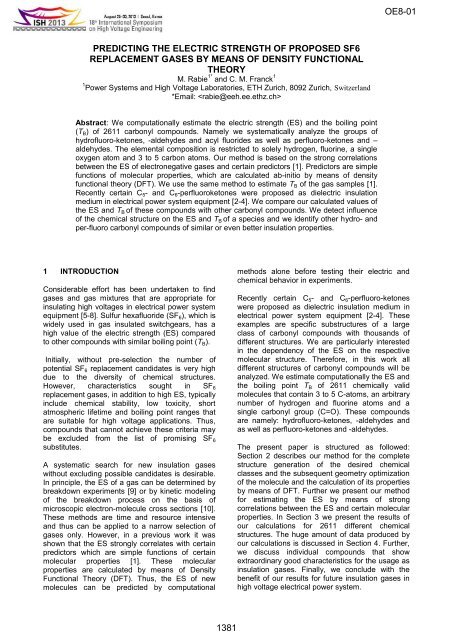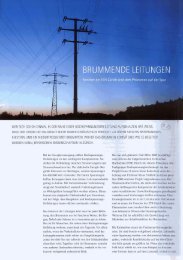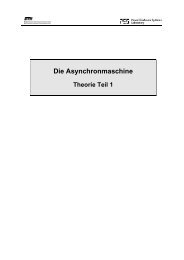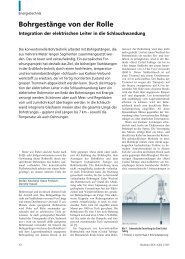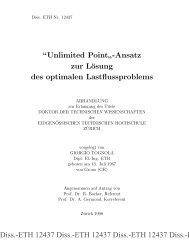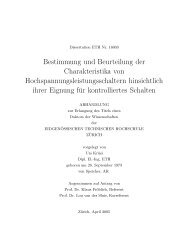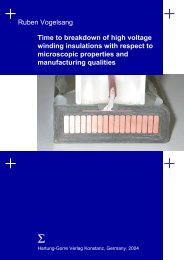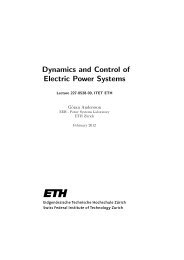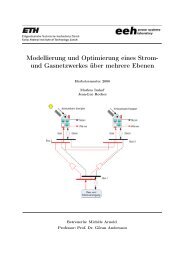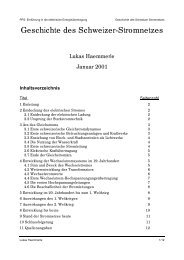predicting the electric strength of proposed sf6 replacement gases ...
predicting the electric strength of proposed sf6 replacement gases ...
predicting the electric strength of proposed sf6 replacement gases ...
You also want an ePaper? Increase the reach of your titles
YUMPU automatically turns print PDFs into web optimized ePapers that Google loves.
OE8-01<br />
PREDICTING THE ELECTRIC STRENGTH OF PROPOSED SF6<br />
REPLACEMENT GASES BY MEANS OF DENSITY FUNCTIONAL<br />
THEORY<br />
M. Rabie 1* and C. M. Franck 1<br />
1 Power Systems and High Voltage Laboratories, ETH Zurich, 8092 Zurich, Switzerland<br />
*Email: <br />
Abstract: We computationally estimate <strong>the</strong> <strong>electric</strong> <strong>strength</strong> (ES) and <strong>the</strong> boiling point<br />
(T B ) <strong>of</strong> 2611 carbonyl compounds. Namely we systematically analyze <strong>the</strong> groups <strong>of</strong><br />
hydr<strong>of</strong>luoro-ketones, -aldehydes and acyl fluorides as well as perfluoro-ketones and –<br />
aldehydes. The elemental composition is restricted to solely hydrogen, fluorine, a single<br />
oxygen atom and 3 to 5 carbon atoms. Our method is based on <strong>the</strong> strong correlations<br />
between <strong>the</strong> ES <strong>of</strong> electronegative <strong>gases</strong> and certain predictors [1]. Predictors are simple<br />
functions <strong>of</strong> molecular properties, which are calculated ab-initio by means <strong>of</strong> density<br />
functional <strong>the</strong>ory (DFT). We use <strong>the</strong> same method to estimate T B <strong>of</strong> <strong>the</strong> gas samples [1].<br />
Recently certain C 5 - and C 6 -perfluoroketones were <strong>proposed</strong> as di<strong>electric</strong> insulation<br />
medium in <strong>electric</strong>al power system equipment [2-4]. We compare our calculated values <strong>of</strong><br />
<strong>the</strong> ES and T B <strong>of</strong> <strong>the</strong>se compounds with o<strong>the</strong>r carbonyl compounds. We detect influence<br />
<strong>of</strong> <strong>the</strong> chemical structure on <strong>the</strong> ES and T B <strong>of</strong> a species and we identify o<strong>the</strong>r hydro- and<br />
per-fluoro carbonyl compounds <strong>of</strong> similar or even better insulation properties.<br />
1 INTRODUCTION<br />
Considerable effort has been undertaken to find<br />
<strong>gases</strong> and gas mixtures that are appropriate for<br />
insulating high voltages in <strong>electric</strong>al power system<br />
equipment [5-8]. Sulfur hexafluoride (SF 6 ), which is<br />
widely used in gas insulated switchgears, has a<br />
high value <strong>of</strong> <strong>the</strong> <strong>electric</strong> <strong>strength</strong> (ES) compared<br />
to o<strong>the</strong>r compounds with similar boiling point (T B ).<br />
Initially, without pre-selection <strong>the</strong> number <strong>of</strong><br />
potential SF 6 <strong>replacement</strong> candidates is very high<br />
due to <strong>the</strong> diversity <strong>of</strong> chemical structures.<br />
However, characteristics sought in SF 6<br />
<strong>replacement</strong> <strong>gases</strong>, in addition to high ES, typically<br />
include chemical stability, low toxicity, short<br />
atmospheric lifetime and boiling point ranges that<br />
are suitable for high voltage applications. Thus,<br />
compounds that cannot achieve <strong>the</strong>se criteria may<br />
be excluded from <strong>the</strong> list <strong>of</strong> promising SF 6<br />
substitutes.<br />
A systematic search for new insulation <strong>gases</strong><br />
without excluding possible candidates is desirable.<br />
In principle, <strong>the</strong> ES <strong>of</strong> a gas can be determined by<br />
breakdown experiments [9] or by kinetic modeling<br />
<strong>of</strong> <strong>the</strong> breakdown process on <strong>the</strong> basis <strong>of</strong><br />
microscopic electron-molecule cross sections [10].<br />
These methods are time and resource intensive<br />
and thus can be applied to a narrow selection <strong>of</strong><br />
<strong>gases</strong> only. However, in a previous work it was<br />
shown that <strong>the</strong> ES strongly correlates with certain<br />
predictors which are simple functions <strong>of</strong> certain<br />
molecular properties [1]. These molecular<br />
properties are calculated by means <strong>of</strong> Density<br />
Functional Theory (DFT). Thus, <strong>the</strong> ES <strong>of</strong> new<br />
molecules can be predicted by computational<br />
methods alone before testing <strong>the</strong>ir <strong>electric</strong> and<br />
chemical behavior in experiments.<br />
Recently certain C 5 - and C 6 -perfluoro-ketones<br />
were <strong>proposed</strong> as di<strong>electric</strong> insulation medium in<br />
<strong>electric</strong>al power system equipment [2-4]. These<br />
examples are specific substructures <strong>of</strong> a large<br />
class <strong>of</strong> carbonyl compounds with thousands <strong>of</strong><br />
different structures. We are particularly interested<br />
in <strong>the</strong> dependency <strong>of</strong> <strong>the</strong> ES on <strong>the</strong> respective<br />
molecular structure. Therefore, in this work all<br />
different structures <strong>of</strong> carbonyl compounds will be<br />
analyzed. We estimate computationally <strong>the</strong> ES and<br />
<strong>the</strong> boiling point T B <strong>of</strong> 2611 chemically valid<br />
molecules that contain 3 to 5 C-atoms, an arbitrary<br />
number <strong>of</strong> hydrogen and fluorine atoms and a<br />
single carbonyl group (C=O). These compounds<br />
are namely: hydr<strong>of</strong>luoro-ketones, -aldehydes and<br />
as well as perfluoro-ketones and -aldehydes.<br />
The present paper is structured as followed:<br />
Section 2 describes our method for <strong>the</strong> complete<br />
structure generation <strong>of</strong> <strong>the</strong> desired chemical<br />
classes and <strong>the</strong> subsequent geometry optimization<br />
<strong>of</strong> <strong>the</strong> molecule and <strong>the</strong> calculation <strong>of</strong> its properties<br />
by means <strong>of</strong> DFT. Fur<strong>the</strong>r we present our method<br />
for estimating <strong>the</strong> ES by means <strong>of</strong> strong<br />
correlations between <strong>the</strong> ES and certain molecular<br />
properties. In Section 3 we present <strong>the</strong> results <strong>of</strong><br />
our calculations for 2611 different chemical<br />
structures. The huge amount <strong>of</strong> data produced by<br />
our calculations is discussed in Section 4. Fur<strong>the</strong>r,<br />
we discuss individual compounds that show<br />
extraordinary good characteristics for <strong>the</strong> usage as<br />
insulation <strong>gases</strong>. Finally, we conclude with <strong>the</strong><br />
benefit <strong>of</strong> our results for future insulation <strong>gases</strong> in<br />
high voltage <strong>electric</strong>al power system.<br />
1381
OE8-01<br />
2 METHODS<br />
2.1 Structure Generation<br />
We use <strong>the</strong> Open Structure Generator OMG [11],<br />
which generates for a given elemental composition<br />
C x H y F z O all chemically valid molecules. The<br />
number <strong>of</strong> C-atoms x, H-atoms y and F-atoms z<br />
are arbitrary integers which provide chemically<br />
valid molecular formulas. The number <strong>of</strong> possible<br />
isomers for one elemental composition growth<br />
dramatically with increasing x as well as <strong>the</strong><br />
computation time for <strong>the</strong> subsequent DFTcalculation<br />
<strong>of</strong> <strong>the</strong> single molecule. Therefore, we<br />
restrict our calculations to <strong>the</strong> class <strong>of</strong> carbonyl<br />
compounds with x = {3, 4, 5}. This initial list <strong>of</strong><br />
molecules generated by OMG contains carbonyl<br />
compounds, alcohols, e<strong>the</strong>rs and o<strong>the</strong>r chemical<br />
groups. We select from this list <strong>the</strong> subset <strong>of</strong><br />
molecules that contain <strong>the</strong> carbonyl group, using<br />
<strong>the</strong> Open Babel-toolbox [12]. This subset we split<br />
into three groups: ketones, aldehydes and acyl<br />
fluorides. The latter are aldehydes where <strong>the</strong><br />
hydrogen atom at <strong>the</strong> carbonyl group is substituted<br />
by a fluor atom.<br />
The molecular structure <strong>of</strong> each generated<br />
molecule is saved as a tmole-file created by <strong>the</strong><br />
Open Babel-toolbox. This file contains <strong>the</strong> entire<br />
structure information <strong>of</strong> <strong>the</strong> molecule as spatial<br />
three-dimensional coordinates <strong>of</strong> <strong>the</strong> atoms.<br />
2.2 Density Functional Calculations<br />
We calculate molecular properties for isolated gas<br />
molecules whose structure has been optimized in<br />
<strong>the</strong> electronic ground state. Vibrational and<br />
temperature corrections have been neglected.<br />
These Kohn-Sham DFT calculations were<br />
performed with <strong>the</strong> Turbomole program package<br />
[13] employing <strong>the</strong> BP86 density functional [14, 15]<br />
in combination with density fitting techniques.<br />
Ahlrichs' polarized valence triple-zeta basis def-<br />
TZVP [16] was applied in <strong>the</strong> calculations <strong>of</strong> ε i<br />
a<br />
while <strong>the</strong> larger def2-QZVPP basis set [17] was<br />
used for <strong>the</strong> calculation <strong>of</strong> α and µ. We perform <strong>the</strong><br />
DFT calculation for <strong>the</strong> neutral and <strong>the</strong> positively<br />
charged molecules to calculate ε i a . We evaluate<br />
energy differences between potential curves <strong>of</strong><br />
neutral molecule and cation, neglecting <strong>the</strong><br />
discrete structure <strong>of</strong> <strong>the</strong> vibrational energy levels.<br />
The quantities α and µ are calculated for <strong>the</strong><br />
geometry-optimized neutral molecule.<br />
2.2 Correlation Method<br />
Within a multiple regression analysis it was shown<br />
that <strong>the</strong>re are clear correlations between <strong>the</strong> ES or<br />
T B <strong>of</strong> an electronegative gas and certain predictors,<br />
which are simple functions <strong>of</strong> selected DFTcalculated<br />
molecular properties [1]. The carbonyl<br />
compounds which are investigated in this work are<br />
polar molecules. For polar <strong>gases</strong> <strong>the</strong> ES and T B<br />
are functions <strong>of</strong> <strong>the</strong> DFT-calculated molecular<br />
properties:<br />
<strong>electric</strong> dipole moment µ<br />
<br />
<br />
<br />
average static electronic polarizability α<br />
adiabatic ionization energy ε i<br />
a<br />
electron number N e<br />
molecular mass m.<br />
We calculate <strong>the</strong> ES <strong>of</strong> polar molecules by <strong>the</strong><br />
linear regression<br />
<br />
<br />
Er<br />
x1 x2 p0 p1x 1<br />
p2x2<br />
, , (1)<br />
with <strong>the</strong> predictors x 1 = µ 0.3 N e<br />
1.3<br />
, x 2 = α 0.6 ε i a2.8 and<br />
<strong>the</strong> coefficients are (p 0 , p 1 , p 2 ) = (- 1.05, 3.8×10 -3 ,<br />
5.6×10 -4 ). Here, E r is <strong>the</strong> ES relative to SF 6 . The<br />
standard deviation <strong>of</strong> <strong>the</strong> calculated values <strong>of</strong> <strong>the</strong><br />
ES with respect to <strong>the</strong> measured values is σ = 0.35<br />
.<br />
The boiling point T B is estimated by<br />
B <br />
T y , y q q y q y , (2)<br />
1 2 0 1 1 2 2<br />
with <strong>the</strong> predictors y 1 = α 0.23 µ 0.04 , y 2 = ε i<br />
a 0.07 m 0.01<br />
and <strong>the</strong> coefficients (p 0 , p 1, p 2 ) = (3.37, 0.27, -2.83)<br />
×10 3 . The calculated values <strong>of</strong> T B have a standard<br />
deviation <strong>of</strong> σ = 28 K.<br />
3 RESULTS<br />
3.1 C3/C4/C5-Carbonyl compounds<br />
Following Section 2, we estimated <strong>the</strong> ES and T B<br />
<strong>of</strong> overall 2611 carbonyl compounds. The structure<br />
generation with OMG yields 4826 species. The<br />
subsequent DFT-structure optimizations <strong>of</strong> <strong>the</strong><br />
neutral as well as <strong>the</strong> positively charged molecules<br />
converge for 2611 structures. The stability <strong>of</strong> <strong>the</strong><br />
cation is necessary to calculate <strong>the</strong> ionization<br />
energy ε i a <strong>of</strong> <strong>the</strong> neutral molecule, as described in<br />
Section 2.2.<br />
Figure 1(a) shows <strong>the</strong> results <strong>of</strong> our analysis for<br />
<strong>the</strong> 48 converged C 3 -compounds, which are<br />
subdivided into 17 ketones, 18 aldehydes and 13<br />
acyl fluorides. The 365 structures <strong>of</strong> <strong>the</strong> C 4 -<br />
compounds consist <strong>of</strong> 138 ketones, 117 aldehydes<br />
and 110 acyl fluorides. The results are displayed in<br />
Figure 1(b). The 2198 structures <strong>of</strong> C 5 - carbonyl<br />
compounds are 923 ketones, 685 aldehydes and<br />
590 acyl fluorides, and <strong>the</strong>ir values <strong>of</strong> E r and T B are<br />
shown in Figure 1(c). The standard deviation σ <strong>of</strong><br />
our calculated values <strong>of</strong> E r and T B is given in<br />
Section 2.2.<br />
1382
OE8-01<br />
Table 1 gives <strong>the</strong> mean values <strong>of</strong> E r and T B for <strong>the</strong><br />
three groups <strong>of</strong> ketones, aldehydes and acyl<br />
aldehydes. Here, is calculated as an average<br />
over all E r <strong>of</strong> <strong>the</strong> compounds <strong>of</strong> one group, e.g. <strong>the</strong><br />
17 ketones.<br />
The influence <strong>of</strong> <strong>the</strong> number <strong>of</strong> F-atoms z on <strong>the</strong><br />
ES <strong>of</strong> a molecular gas is illustrated in Figure 2.<br />
Here, we calculate <strong>the</strong> mean values and <br />
<strong>of</strong> C 5 -hydr<strong>of</strong>luoro carbonyl compounds with<br />
elemental composition C 5 H y F z O, where <strong>the</strong> mean<br />
values are taken over an ensemble <strong>of</strong> molecules<br />
with fixed z and arbitrary y. We choose z from 0 to<br />
9 F-atoms. For perfluoro-carbonyl compounds <strong>the</strong><br />
number <strong>of</strong> F-atoms is z = 10 and <strong>the</strong> number <strong>of</strong><br />
different isomers resulting from our analysis is n =<br />
0 for<br />
Table 1: Mean values <strong>of</strong> Electric <strong>strength</strong> ,<br />
boiling point and number <strong>of</strong> F-atoms <strong>of</strong><br />
different groups. The mean values are taken over n<br />
molecules.<br />
group <br />
[rel. SF 6]<br />
<br />
[K]<br />
<br />
C 3-Ketones 0.39 319 2.00 17<br />
C 3-Aldehydes 0.56 320 1.89 18<br />
C 3-Acyl Fluorides 0.98 293 3.15 13<br />
C 4-Ketones 0.69 352 2.58 138<br />
C 4-Aldehydes 0.77 345 2.39 117<br />
C 4-Acyl Fluorides 1.14 326 3.36 110<br />
C 5-Ketones 0.94 375 3.30 923<br />
C 5-Aldehydes 1.00 370 2.91 685<br />
C 5-Acyl Fluorides 1.35 356 3.85 590<br />
SF 6 1 209 [18] 6 1<br />
n<br />
<strong>the</strong> group <strong>of</strong> aldehydes, n = 1 for <strong>the</strong> group <strong>of</strong> acyl<br />
aldehydes and n = 2 for <strong>the</strong> group <strong>of</strong> ketones.<br />
Thus, mean values are not meaningful in this case.<br />
It can be clearly seen from Figure 2 that for all<br />
three groups increases whereas <br />
decreases as z increases.<br />
Figure 3 (a) displays again <strong>the</strong> data points <strong>of</strong><br />
Figure 1, but divided into <strong>the</strong> three classes <strong>of</strong> C 3 -,<br />
C 4 - and C 5 - carbonyl compounds. Thus, <strong>the</strong><br />
influence <strong>of</strong> <strong>the</strong> number <strong>of</strong> C-atoms on <strong>the</strong> ES and<br />
T B can be seen more clearly.<br />
Figure 1: Predicted <strong>electric</strong> <strong>strength</strong> E r relative to<br />
SF 6 vs predicted boiling point T B for 2611 carbonyl<br />
compounds containing (a) 3, (b) 4 and (c) 5 C-<br />
atoms. The data set contains 48 C 3 -, 365 C 4 - and<br />
2198 C 5 - carbonyl compounds, and it is split into<br />
ketones, aldehydes and acyl fluorides (triangles).<br />
The star indicates <strong>the</strong> measured values <strong>of</strong> E r and<br />
T B <strong>of</strong> SF 6 [18].<br />
Figure 2: Mean values <strong>of</strong> E r vs mean values <strong>of</strong> T B<br />
for hydr<strong>of</strong>luoro-carbonyl compounds containing 5<br />
C-atoms and 0 to 9 F-atoms (for <strong>the</strong> definition <strong>of</strong><br />
“mean value” see text). The solid lines connect <strong>the</strong><br />
data points <strong>of</strong> molecules with arbitrary number <strong>of</strong><br />
H-atoms but different number <strong>of</strong> F-atoms to guide<br />
<strong>the</strong> eye. The number <strong>of</strong> F-atoms increases from<br />
right to left.<br />
1383
OE8-01<br />
3.2 Molecules <strong>of</strong> high ES and low T B<br />
In this section we give detailed results for selected<br />
molecules that might be interesting candidate<br />
<strong>gases</strong> due to <strong>the</strong>ir relatively high values <strong>of</strong> E r and<br />
low values <strong>of</strong> T B . In general, <strong>the</strong>se are <strong>the</strong><br />
molecules in <strong>the</strong> upper left corner <strong>of</strong> Figure 3(a).<br />
The data points in <strong>the</strong> inset are plotted in Figure<br />
3(b). The selected C 3 -compounds are enumerated<br />
with increasing T B from (1) to (4), <strong>the</strong> C 4 -<br />
compounds from (5) to (7) and <strong>the</strong> C 5 -compounds<br />
from (8) to (12). The values <strong>of</strong> E r and T B for <strong>the</strong>se<br />
structures are given in Table 2. We also compare<br />
<strong>the</strong> data <strong>of</strong> <strong>the</strong>se molecules with values <strong>of</strong> <strong>the</strong><br />
boiling point T B L predicted by o<strong>the</strong>r methods [20].<br />
The molecules (1) and (2) are perfluorocompounds,<br />
whereas (3) and (4) are hydr<strong>of</strong>luorocompounds<br />
with 1 and 2 H-atoms, respectively.<br />
The DFT-optimization with Turbomole <strong>of</strong> <strong>the</strong> C 4 -<br />
compounds results in no stable geometry for<br />
compounds with z = 8, although OMG generates 3<br />
isomers for C 4 F 8 O. Thus, <strong>the</strong> best results for E r<br />
and T B are given by <strong>the</strong> hydr<strong>of</strong>luoro-compounds (5)<br />
to (6). The compounds with <strong>the</strong> highest value <strong>of</strong> E r<br />
are generally <strong>the</strong> C 5 -perfluoro-compounds and C 5 -<br />
hydr<strong>of</strong>luoro-compounds with only one or two H-<br />
atoms. The values <strong>of</strong> E r and T B for <strong>the</strong> ketones (9)<br />
and (11) explicitly mentioned in [2] as well as <strong>the</strong><br />
perfluoro-aldehyde (8) and <strong>the</strong> acyl fluorides (10)<br />
and (12) are listed in Table 2.<br />
In addition to <strong>the</strong> C 5 -carbonyl compounds we<br />
estimated <strong>the</strong> <strong>electric</strong> <strong>strength</strong> for <strong>the</strong> perfluoro(2-<br />
methyl-3-pentanone)-compound C 6 F 12 O, <strong>proposed</strong><br />
in [2-4]. Its boiling point is 322 K and due to<br />
photolysis in sunlight within approximately 5 days it<br />
has very low global warming and ozone depletion<br />
potential [2]. Our calculated values for this gas are<br />
E r = 2.44 and T B = 314 K.<br />
Table 2: Values <strong>of</strong> E r [rel. SF 6 ], T B [K] and T B L [K]<br />
[20] for selected compounds.<br />
Nr SMILES E r T B T B<br />
L<br />
C 3 –compounds<br />
(1) FC(=O)C(C(F)(F)F)(F)F 1.34 255 280<br />
(2) O=C(C(F)(F)F)C(F)(F)F 1.03 262 280<br />
(3) FC(C(C(=O)F)(F)F)F 1.11 263 288<br />
(4) FC(=O)CC(F)(F)F 1.31 278 302<br />
C 4 –compounds<br />
(5) FC(=O)C(C(C(F)(F)F)F)(F)F 1.63 270 317<br />
(6) FC(C(C(F)(F)F)(C(=O)F)F)F 1.82 277<br />
(7) FCC(C(F)(F)F)(C(=O)F)F 1.91 295<br />
C 5 –compounds<br />
(8) FC(=O)C(C(F)(F)F)(C(F)(F)F)C(F)(F)F 2.77 283 303<br />
(9) O=C(C(C(F)(F)F)(C(F)(F)F)F)C(F)(F)F 1.93 293 310<br />
(10) FC(C(C(C(F)(F)F)(F)F)(C(=O)F)F)F 2.28 296<br />
(11) O=C(C(C(C(F)(F)F)(F)F)(F)F)C(F)(F)F 2.01 302 322<br />
(12) FC(=O)C(C(C(F)(F)F)C(F)(F)F)(F)F 2.67 304<br />
Figure 3: (a) Predicted <strong>electric</strong> <strong>strength</strong> E r relative<br />
to SF 6 vs predicted boiling point T B for 2611<br />
molecules. The complete list <strong>of</strong> molecules is split<br />
into carbonyl compounds containing 3 (triangles), 4<br />
(circles) and 5 carbon atoms (dots). (b) Inset <strong>of</strong><br />
Figure 3(a) with all molecules with values in <strong>the</strong><br />
Interval T B = [230, 320] and E r = [0.9, 2.9]. The<br />
compounds (1) to (12) are listed in Table 2, 3 and<br />
4. The compound C 6 F 12 O from [2-4] is indicated by<br />
<strong>the</strong> cross.<br />
Figure 4: From left to right: 2D-structures <strong>of</strong><br />
molecules Nr (1) to (4) <strong>of</strong> Table 2, taken from<br />
PubChem [19]. In this representation hydrogen<br />
atoms are not indicated with symbols.<br />
1384
OE8-01<br />
Figure 4: From left to right: 2D-structures <strong>of</strong><br />
molecules (8), (9) and (11) from Table 2, taken<br />
from PubChem [19].<br />
4 DISCUSSION<br />
Our analysis estimates <strong>the</strong> ES and T B <strong>of</strong> a large<br />
number <strong>of</strong> molecules. However, not for all possible<br />
OMG-generated structures <strong>the</strong> DFT-optimization<br />
converges to a stable geometry. This may have a<br />
computational or a physical reason: Ei<strong>the</strong>r <strong>the</strong><br />
OMG-generated geometry is not accurate and<br />
<strong>the</strong>refore <strong>the</strong> structure optimization <strong>of</strong> <strong>the</strong> molecule<br />
exceeds <strong>the</strong> computation-time, or a stable cation<br />
state does not exist and it dissociates during <strong>the</strong><br />
structure optimization into smaller fractions. Then<br />
<strong>the</strong> calculation <strong>of</strong> ε a<br />
i and thus <strong>the</strong> ES is not<br />
possible. However, <strong>the</strong> sample <strong>of</strong> calculated data<br />
is sufficient and it is reasonable to assume that <strong>the</strong><br />
ES and T B will not significantly change for notincluded<br />
molecules.<br />
We clearly observe certain trends for <strong>the</strong> ES and<br />
T B . The values <strong>of</strong> <strong>the</strong>se quantities strongly vary<br />
with <strong>the</strong> elemental composition and <strong>the</strong> molecular<br />
structure, as illustrated in Figure 1, 2 and 3. The<br />
dependency <strong>of</strong> <strong>the</strong> ES on <strong>the</strong> chemical group<br />
becomes clear from Table 1: <strong>the</strong> mean values <strong>of</strong><br />
<strong>the</strong> ES <strong>of</strong> <strong>the</strong> ketones are always smaller than <strong>the</strong><br />
ones <strong>of</strong> <strong>the</strong> aldehydes. We do not observe this<br />
effect due to increasing number <strong>of</strong> F-atoms ,<br />
since <strong>of</strong> <strong>the</strong> aldehydes is even smaller than<br />
<strong>of</strong> <strong>the</strong> ketones. The group <strong>of</strong> acyl fluorides<br />
always shows both highest values <strong>of</strong> E r and lowest<br />
values <strong>of</strong> T B . We note that is larger for <strong>the</strong> acyl<br />
fluorides than for both <strong>the</strong> aldehydes and <strong>the</strong><br />
ketones due <strong>the</strong> forbidden elemental composition<br />
C x H 2x O for <strong>the</strong> acyl-fluorides.<br />
In general, increasing number <strong>of</strong> C-atoms in a<br />
molecule increases <strong>the</strong> rate <strong>of</strong> elastic collisions,<br />
and thus <strong>the</strong> ES, as shown in Figure 3(a). The<br />
increased value <strong>of</strong> T B for larger molecules is <strong>the</strong><br />
result <strong>of</strong> increasing van der Waals interaction. As<br />
illustrated in Figure 2, for increasing number <strong>of</strong> F-<br />
atoms z <strong>the</strong> ES increases due to <strong>the</strong> higher rate <strong>of</strong><br />
electron attachment. Fur<strong>the</strong>r, we find a surprisingly<br />
strong decrease <strong>of</strong> T B as z increases. We believe<br />
that strongly fluorized molecules suffer from<br />
decreasing hydrogen bond attraction.<br />
The selected molecules <strong>of</strong> Section 3.2 show good<br />
characteristics for insulation <strong>gases</strong>. On <strong>the</strong> one<br />
hand <strong>the</strong> C 3 - acyl fluorides (1) to (3) and <strong>the</strong><br />
ketone (2) show values <strong>of</strong> <strong>the</strong> ES only slightly<br />
larger than SF 6 and low values <strong>of</strong> T B compared to<br />
<strong>the</strong> C 4 and C 5 -compounds. On <strong>the</strong> o<strong>the</strong>r hand <strong>the</strong><br />
C 5 -compounds show <strong>the</strong> highest values <strong>of</strong> <strong>the</strong> ES,<br />
but slightly larger values <strong>of</strong> T B . Indeed, <strong>the</strong> ketones<br />
(9) and (11) from [2] show desirable properties.<br />
However, <strong>the</strong>re seems to be ano<strong>the</strong>r ideal<br />
candidate for <strong>electric</strong>al insulation, <strong>the</strong> perfluoroaldehyde<br />
(8). Its value <strong>of</strong> <strong>the</strong> ES clearly exceeds<br />
<strong>the</strong> one <strong>of</strong> all o<strong>the</strong>r molecules with similar T B .<br />
5 CONCLUSION<br />
Within a systematic procedure we calculated <strong>the</strong><br />
<strong>electric</strong> <strong>strength</strong> and <strong>the</strong> boiling point <strong>of</strong> more than<br />
2000 hydr<strong>of</strong>loro- and perfluoro- carbonyl<br />
compounds in a computational efficient way.<br />
Strong influence <strong>of</strong> <strong>the</strong> chemical structure and <strong>the</strong><br />
elemental composition on <strong>the</strong>se gas quantities was<br />
measured. Moreover, interesting candidates with<br />
predicted values <strong>of</strong> <strong>the</strong> <strong>electric</strong> <strong>strength</strong> higher than<br />
SF 6 were identified. O<strong>the</strong>r important characteristics<br />
<strong>of</strong> SF 6 <strong>replacement</strong> <strong>gases</strong> as chemical stability,<br />
toxicity and atmospheric lifetime were not within<br />
<strong>the</strong> scope <strong>of</strong> this paper but might be analyzed in<br />
combination with chemical databases in future. A<br />
quantitative investigation <strong>of</strong> <strong>the</strong> <strong>electric</strong> <strong>strength</strong><br />
should follow for <strong>the</strong> top-candidates, e.g. by Swarm<br />
parameter measurements and <strong>the</strong> derivation <strong>of</strong> <strong>the</strong><br />
critical <strong>electric</strong> field <strong>strength</strong> [21].<br />
6 REFERENCES<br />
[1] M. Rabie, D. A. Dahl, S. M. A. Donald, M.<br />
Reiher, C. M. Franck “Predictors for Gases <strong>of</strong><br />
High Electric Strength”, accepted for<br />
publication in IEEE TDEI, 2013<br />
[2] K. J. Warren, P. E. Tuma, J. G. Owens, R. M.<br />
Minday, “Perfluoroketones as Gaseous<br />
Di<strong>electric</strong>s”, Patent WO 2011 090992A1, 2011<br />
[3] M. Ingold, T. A. Paul, J. Mantilla et al:<br />
“Di<strong>electric</strong> Insulation Medium”, Patent WO<br />
2012/080269 A1, 2012<br />
[4] J. Mantilla, M.-S. Claessens, N. Gariboldi et al:<br />
“Di<strong>electric</strong> Insulation Medium”, Patent WO<br />
2012/080246 A1, 2012<br />
[5] J. C. Devins: “Replacement Gases for SF6”,<br />
IEEE TDEI, Vol. 15, pp. 81-86, 1980<br />
[6] L. G. Christophorou, R. J. Van Brunt: “SF6/N2<br />
mixtures: basic and HV insulation properties”,<br />
IEEE TDEI, Vol. 2, pp. 952-1003, 1995<br />
[7] L. G. Christophorou, J. K. Olth<strong>of</strong>f, D. S. Green:<br />
“Gases for Electrical Insulation and Arc<br />
Interruption: Possible Present and Future<br />
Alternatives to Purse SF6”, NIST Technical<br />
Note 1425, 1997<br />
[8] L. Niemeyer: “A Systematic Search for<br />
Insulation Gases and Their Environmental<br />
Evaluation”, Gaseous Di<strong>electric</strong>s VIII, pp. 459-<br />
464, 1998<br />
[9] G. Biasutti, “Neue Isoliergase für gekapselte<br />
Hochspannungsanlagen”, Ph.D. Thesis, Diss.<br />
ETH Nr. 7683, 1985<br />
1385
OE8-01<br />
[10] R. E. Robson, P. Nicoletopoulos, B. Li, R. D.<br />
White, “Kinetic <strong>the</strong>oretical and fluid modelling<br />
<strong>of</strong> plasmas and swarms: <strong>the</strong> big picture”,<br />
Plasma Sources Science and Technology, Vol.<br />
17, pp. 024020, 2008<br />
[11] J. Peironcely, M. R. Cherto, D. Fichera, T.<br />
Reijmers, L. Coulier, J. L. Faulon, T.<br />
Hankemeier, “OMG: open molecule generator”,<br />
Journal <strong>of</strong> Cheminformatics, Vol. 4:1, 2012<br />
[12] N. O’Boyle, M. Banck, C. James, C. Morley, T.<br />
Vandermeersch, G. Hutchison: “Open babel:<br />
An open chemical toolbox”, Journal <strong>of</strong><br />
Cheminformatics, Vol. 3, pp. 33, 2011<br />
[13] R. Ahlrichs, M. Bär, M. Häser, H. Horn, C.<br />
Kölmel, “Electronic structure calculations on<br />
workstation computers: The program system<br />
turbomole”, Chemical Phys. Lett., Vol. 162, pp.<br />
165-169, 1989<br />
[14] A. D. Becke, “Density-functional exchangeenergy<br />
approximation with correct asymptotic<br />
behavior”, Phys. Rev. A, Vol. 38, pp. 3098-<br />
3100, 1988<br />
[15] J.P.Perdew, “Density-functional approximation<br />
for <strong>the</strong> correlation energy <strong>of</strong> <strong>the</strong><br />
inhomogeneous electron gas”, Phys. Rev. B,<br />
Vol. 33, pp. 8822-8824, 1986<br />
[16] A. Schaefer, C. Huber, R. Ahlrichs, “Fully<br />
optimized contracted Gaussian basis sets <strong>of</strong><br />
triple zeta valence quality for atoms Li to Kr”, J.<br />
Chem. Phys., Vol. 100, pp. 5829-5835, 1994<br />
[17] F. Weigend, F. Furche, R. Ahlrichs, “Gaussian<br />
basis sets <strong>of</strong> quadruple zeta valence quality for<br />
atoms H–Kr”, J. Chem. Phys., Vol. 119, pp.<br />
12753-12762, 2003<br />
[18] E. Bolton, Y. Wang, P. A. Thiessen, S. H.<br />
Bryant: “PubChem: Integrated Platform <strong>of</strong><br />
Small Molecules and Biological Activities”,<br />
Annual Reports in Computational Chemistry,<br />
Vol. 4, Chapter 12, 2008<br />
[19] National Inst. Sci, Techn. (NIST), USA,<br />
Chemistry WebBook, 2011<br />
[20] ChemSpider-Database,<br />
http://www.chemspider.com, 12.04.2013<br />
[21] D. A. Dahl, T. H. Teich, C. M. Franck,<br />
“Obtaining precise electron swarm parameters<br />
from a pulsed Townsend setup”, J. Phys. D:<br />
Appl. Phys., Vol. 45, pp. 485201, 2012<br />
1386


